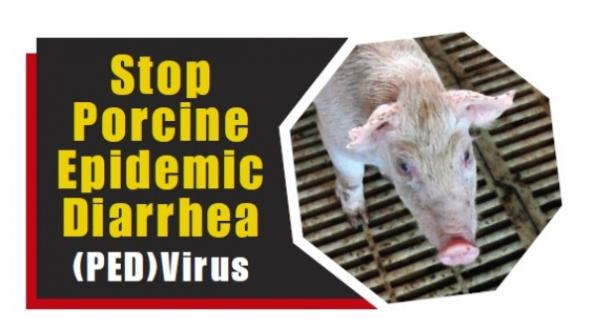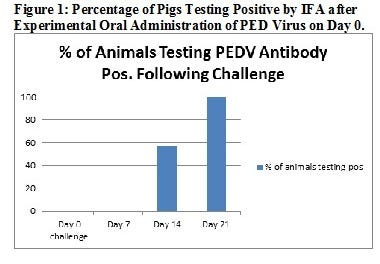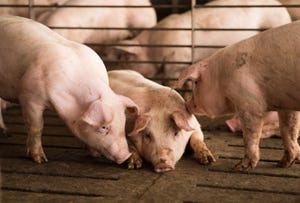Developing a Test to Detect PED Virus Antibodies
September 30, 2013

The first diagnosis of porcine epidemic diarrhea (PED) virus in the United States was confirmed in Iowa in mid-May 2013 by the National Veterinary Services Laboratories (NVSL) at Ames. The two tests to diagnose active infections (disease) that became immediately available were polymerase chain reaction (PCR) and immunohistochemistry (IHC).
The next step was to develop a diagnostic test that could detect antibodies to PED virus to determine if pigs were previously infected with this virus.
In late August 2013, the Iowa State University Veterinary Diagnostic Laboratory (ISUVDL) introduced an immunofluorescence assay (IFA) for detection of antibodies to PED virus. Development of the IFA test was the result of collaborative efforts of ISUVDL virologists ( K.J. Yoon, DVM; J.Q. Zhang, DVM; and their graduate students) and the financial support of the Iowa Pork Producers Association. This team successfully isolated and propagated PED virus in cell culture, which allowed the development of the IFA.
Like what you’re reading? Subscribe to the National Hog Farmer Weekly Preview newsletter and get the latest news delivered right to your inbox every week!
While this IFA is the first antibody test to be made available in the United States, efforts to develop and improve other types of antibody tests for PED virus are ongoing at ISUVDL as well as other laboratories.
Following are some of the frequently asked questions surrounding PED virus antibody testing at ISUVDL:
Q. We want to reduce the risk of new herd introductions to a sow farm being a source of PED virus. How should we test replacement stock while in isolation or prior to entry?
A. We recommend an approach that mirrors what many use today for porcine reproductive and respiratory syndrome (PRRS) surveillance testing, that is, using an agent detection test in combination with an antibody detection test. The agent detection testing tries to answer the question: “Is PED virus present in animals or the environment today?” whereas, the antibody testing tries to answer the question: “Have these pigs been previously infected with PED virus?”
To determine if PED virus is active or circulating in the population at the time of sampling, the PCR test is used. If PCR is positive, it suggests that the PED virus nucleic acid is present in feces, oral fluids or intestine – and that the PED virus infection is active or quite recent. However, a negative PCR test does not mean animals have never been exposed to the virus. Therefore, the IFA antibody test is conducted on serum samples and if positive, suggests the pigs have been infected with PED virus for at least two weeks and perhaps much longer.
The thought process behind this two-pronged testing approach is that if we are in the early stages of an infection (first 30 days of infection), most pigs will be shedding virus, which will be picked up by the PCR test. If we are testing animals that are further removed from actual infection, then PCR results could be negative. However, the antibody response occurs 14-21 days after initial infection, so that animals in later stages of active infection or those previously infected should have detectable antibodies in their serum. The lag time from time of infection to first detectable antibody response by the IFA appears to be between two and three weeks, with all pigs experimentally infected being serologically positive by three weeks post-infection (Figure 1).

Using these two diagnostic tools in combination should allow us to: 1. Detect very acute infections where an antibody response has not yet occurred; and 2. Detect an antibody response as a historical record to suggest the animals have encountered PED virus previously.
Q. Our sow farm broke with PED virus and we attempted to expose the entire farm to the virus via feedback techniques. Why are we still experiencing individual litters with severe diarrhea?
A. One reason for inconsistent herd immunity may be that subpopulations of sows may be present that have low or no immunity to the PED virus, or perhaps were never infected. The PED virus IFA can be used in these instances to determine whether uniform PED virus exposure has occurred in all sows and gilts. This can be done by comparing the level of antibodies to PED virus in sows, which are farrowing litters that develop diarrhea and vomiting in those sows that raise unaffected litters.
At this time, we do not know if there will be a direct correlation between the IFA titer to PED virus and protective immunity. Efforts are underway to develop a virus neutralization (VN) test, which detects antibodies that prevent the virus from replicating in intestinal lining cells. This will be a better tool to evaluate actual protective immunity.
Q. Since the clinical signs of PED virus vary widely in weaned, grower and finisher pigs, how can we know if pigs have been infected with PED virus?
A. There are reports of extreme variability in severity of diarrhea in postweaned pigs. In some cases, the diarrhea is very mild and difficult to distinguish from other diseases (e.g. rotavirus, TGE, salmonellosis, ileitis, Brachyspira) by visual appraisal of clinical signs.
If pigs are not sampled and tested during acute stages of diarrhea, an infection with PED virus can easily be missed. Knowing the infection status of weaned pigs will be particularly important when introducing breeding stock or establishing transportation or manure removal schedules.
The PED virus IFA will detect antibodies in pigs at 14 – 21 days after infection (Figure 1). A positive test will confirm previous exposure to PED virus, which is particularly useful in later stages of infection when PCR testing may be negative.
Summary
Much of what we need to learn about PED virus will become apparent in the coming months. Many questions remain to be answered surrounding the epidemiology of the PED virus.
Researchers at many diagnostic facilities continue to work diligently to come up with diagnostic tools that can beneficially aid veterinarians and producers in accurate diagnosis and provision of informative risk assessments.
One tool that may be useful is routine serologic surveillance testing for PED virus using IFA, particularly as a monitoring tool for assurance of PED virus-free status.
You might also like:
High Hog Prices Negated by Feed Costs
You May Also Like



